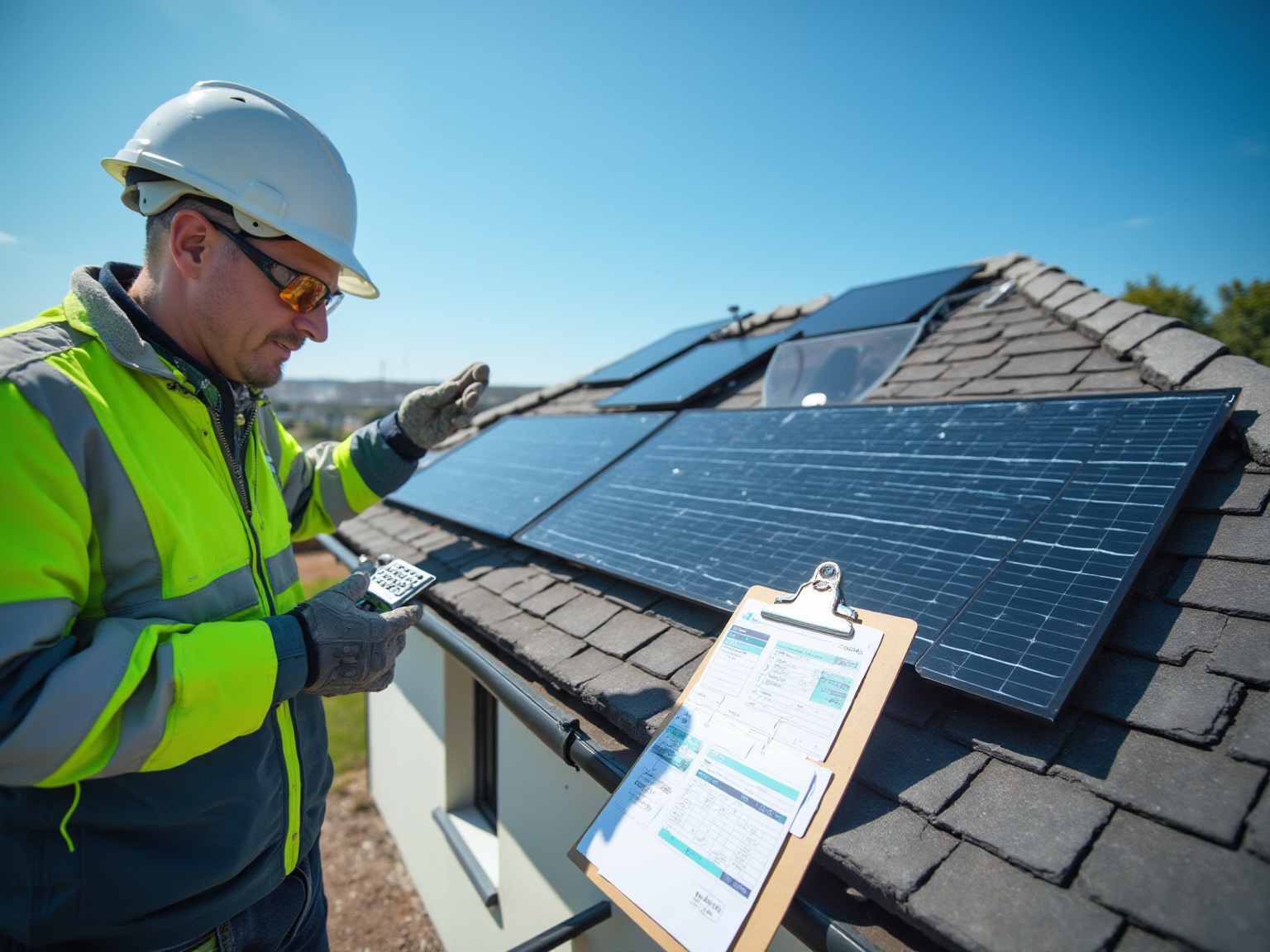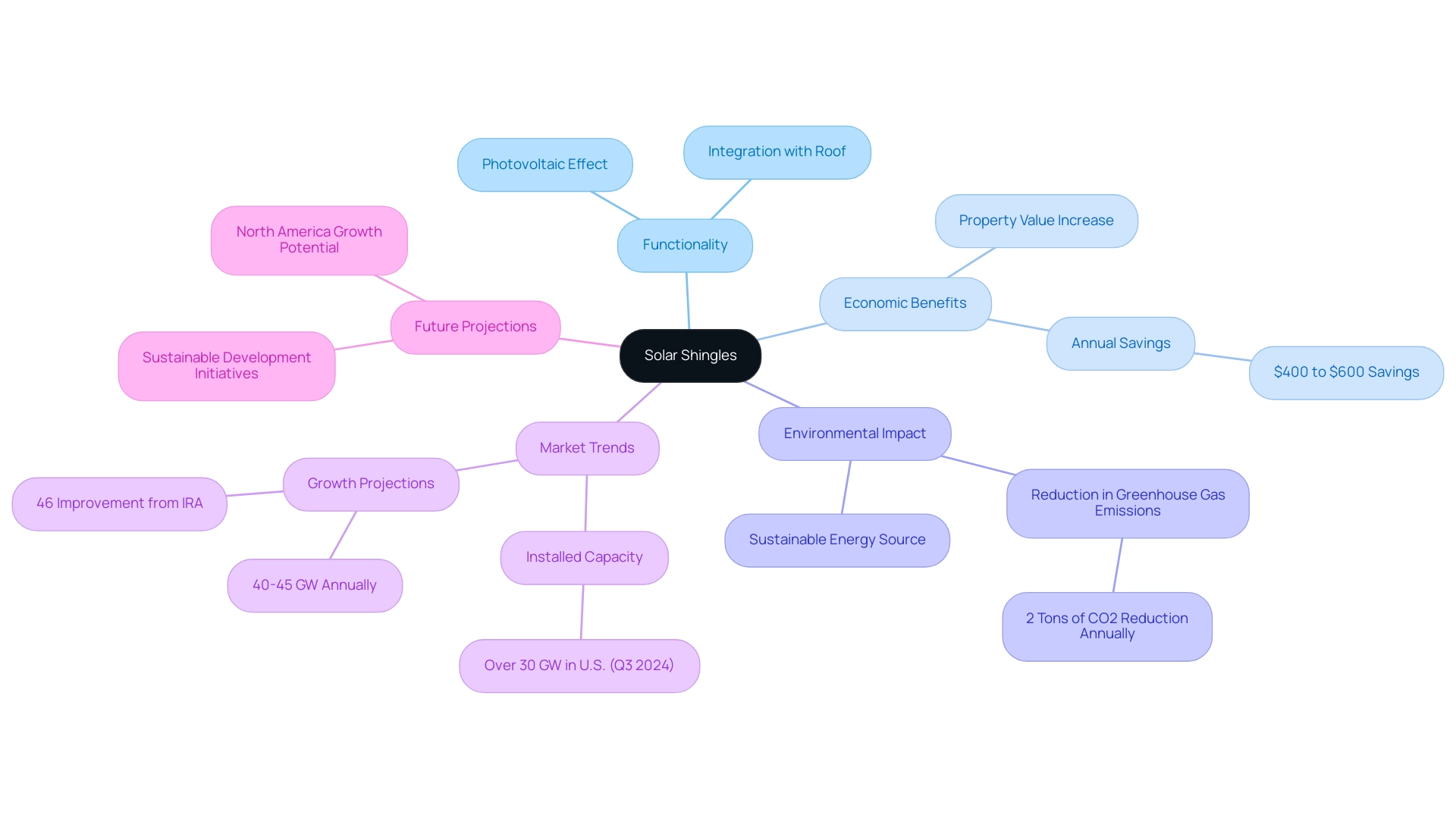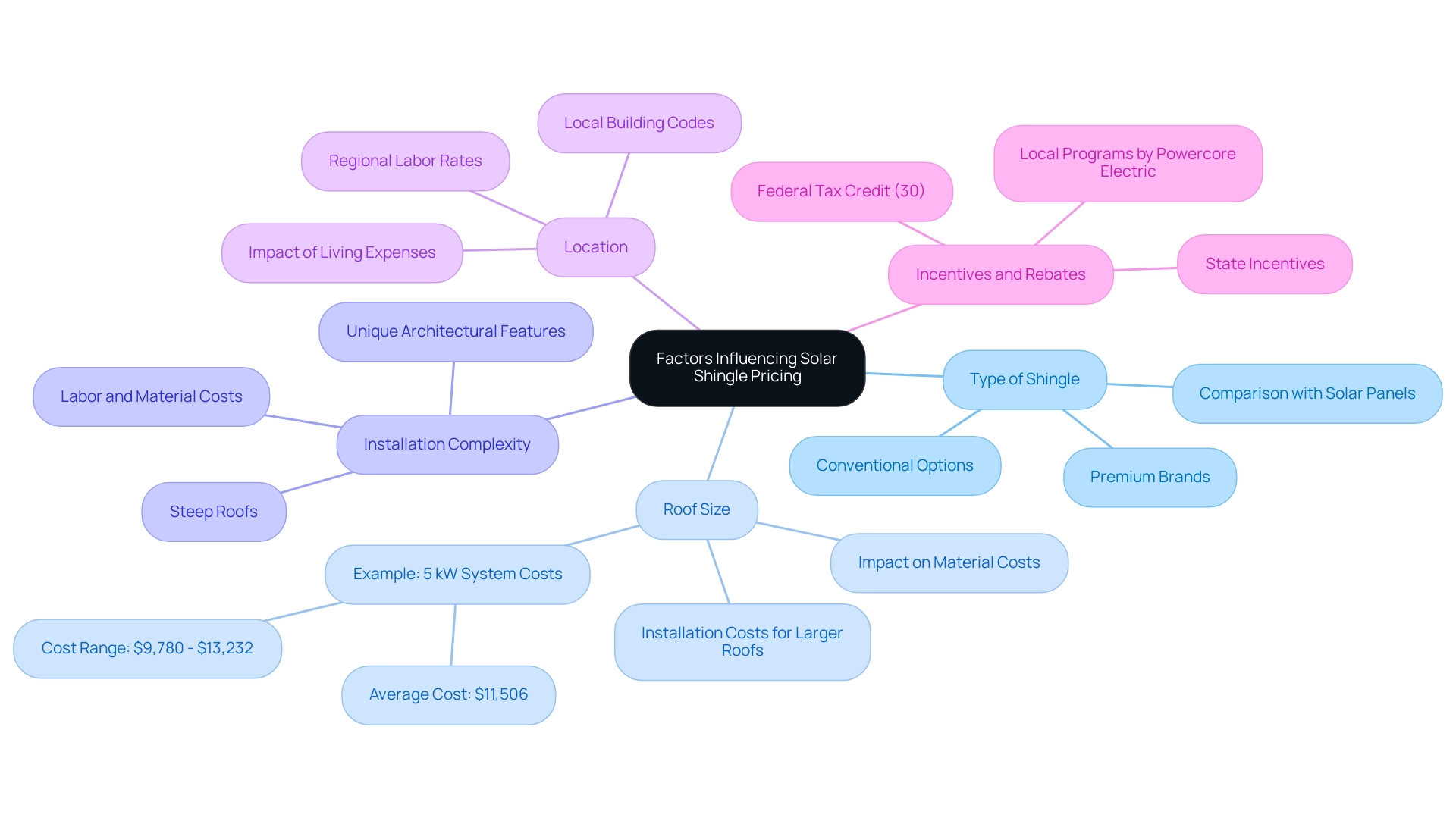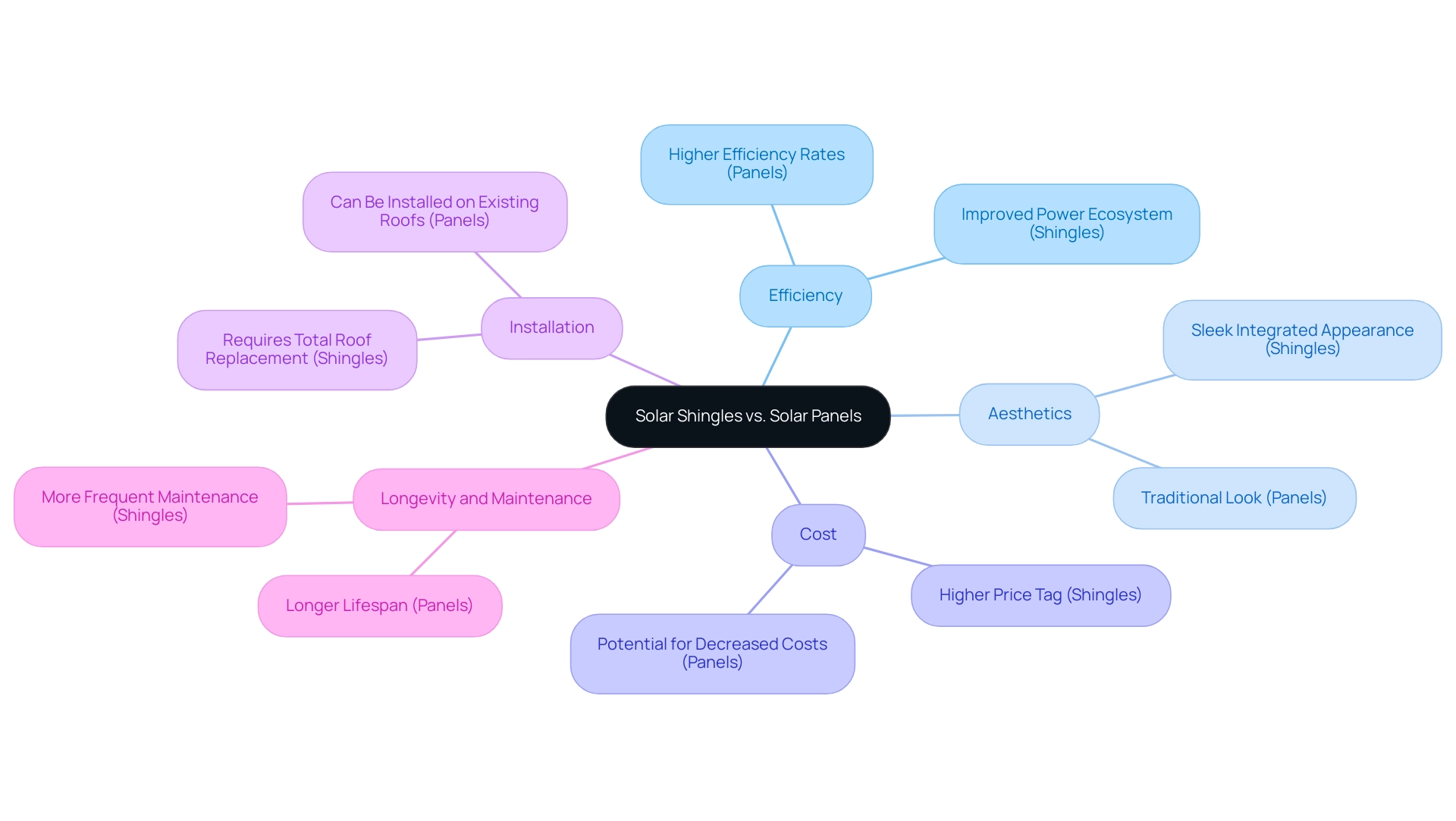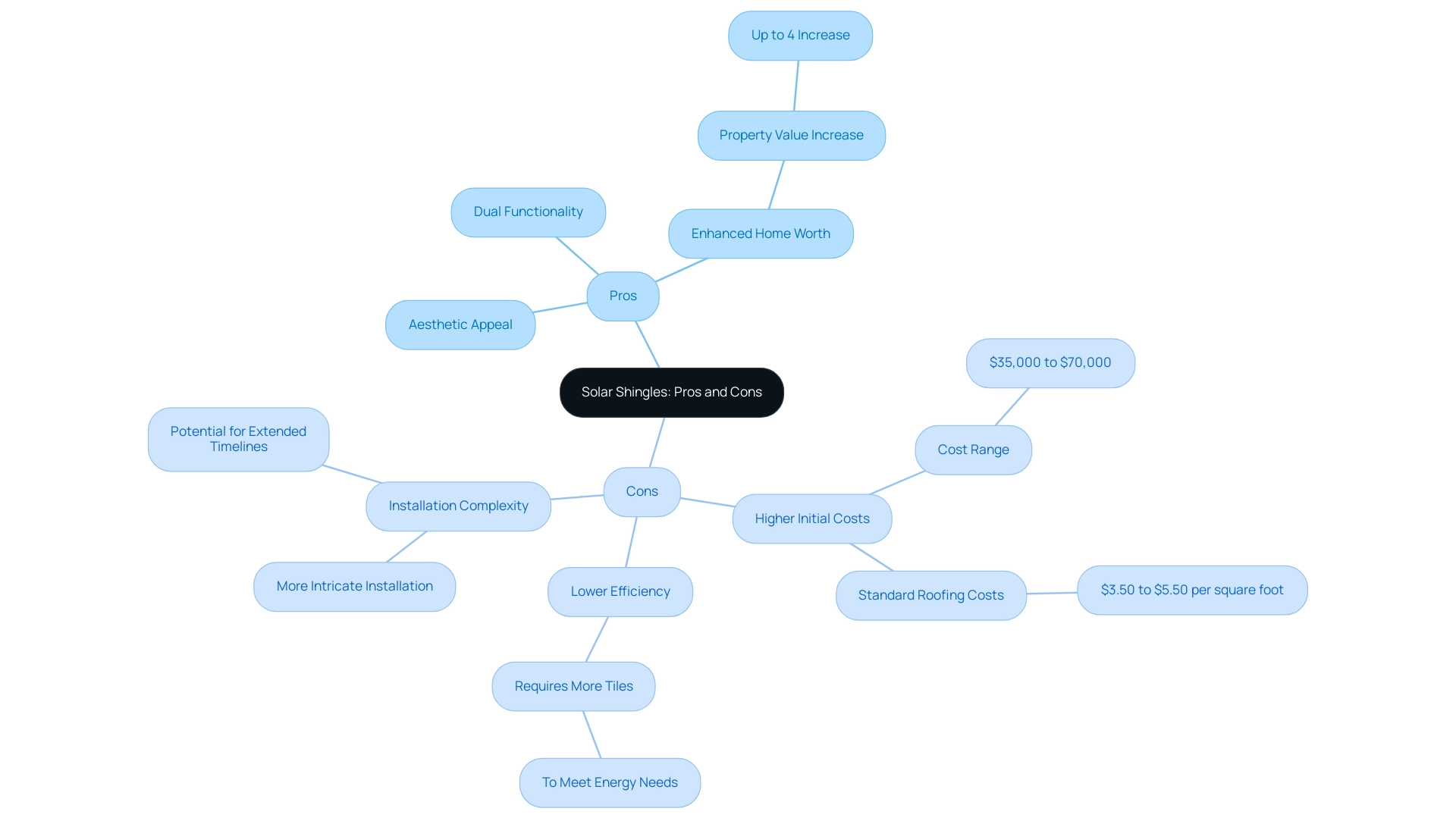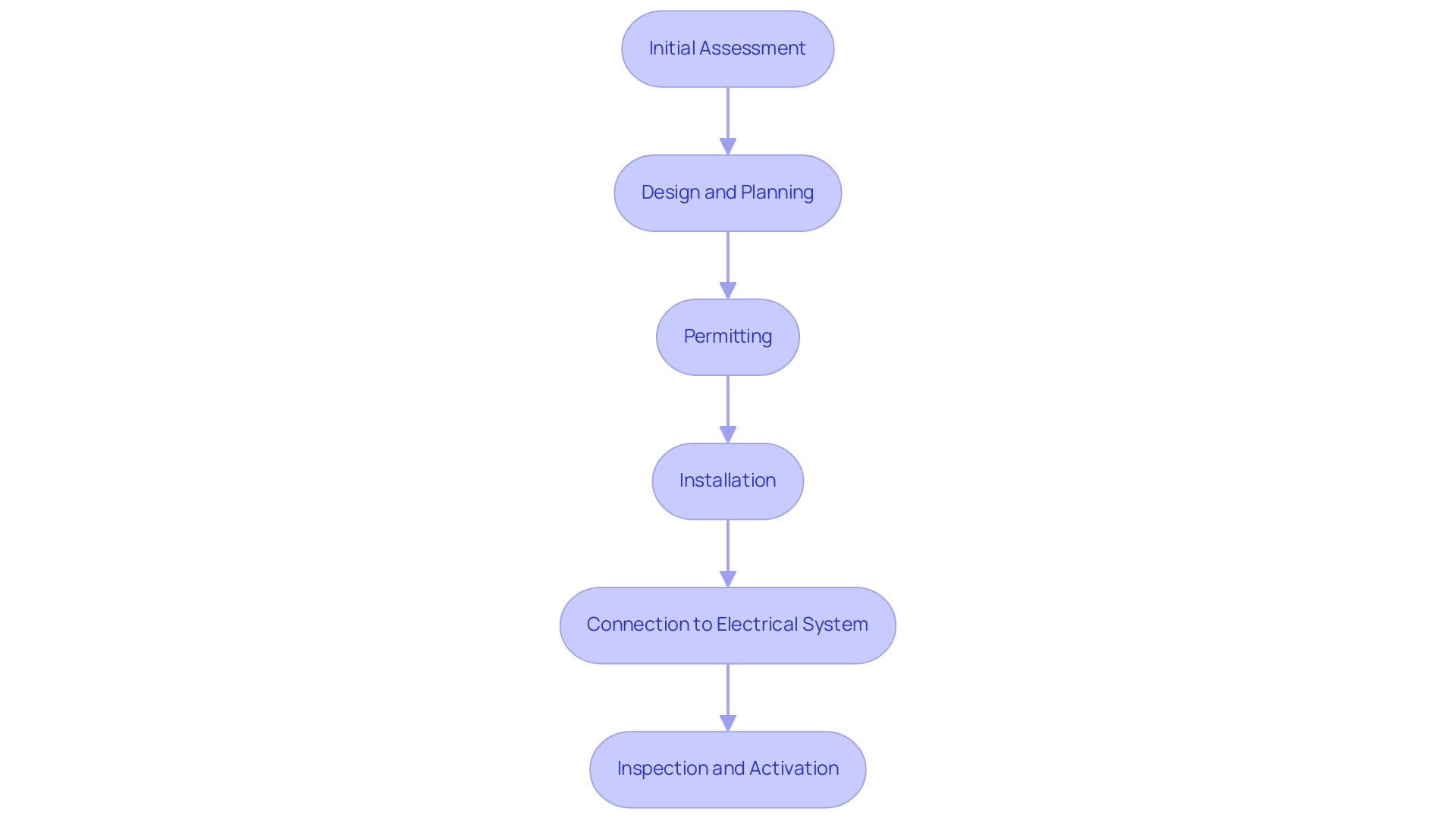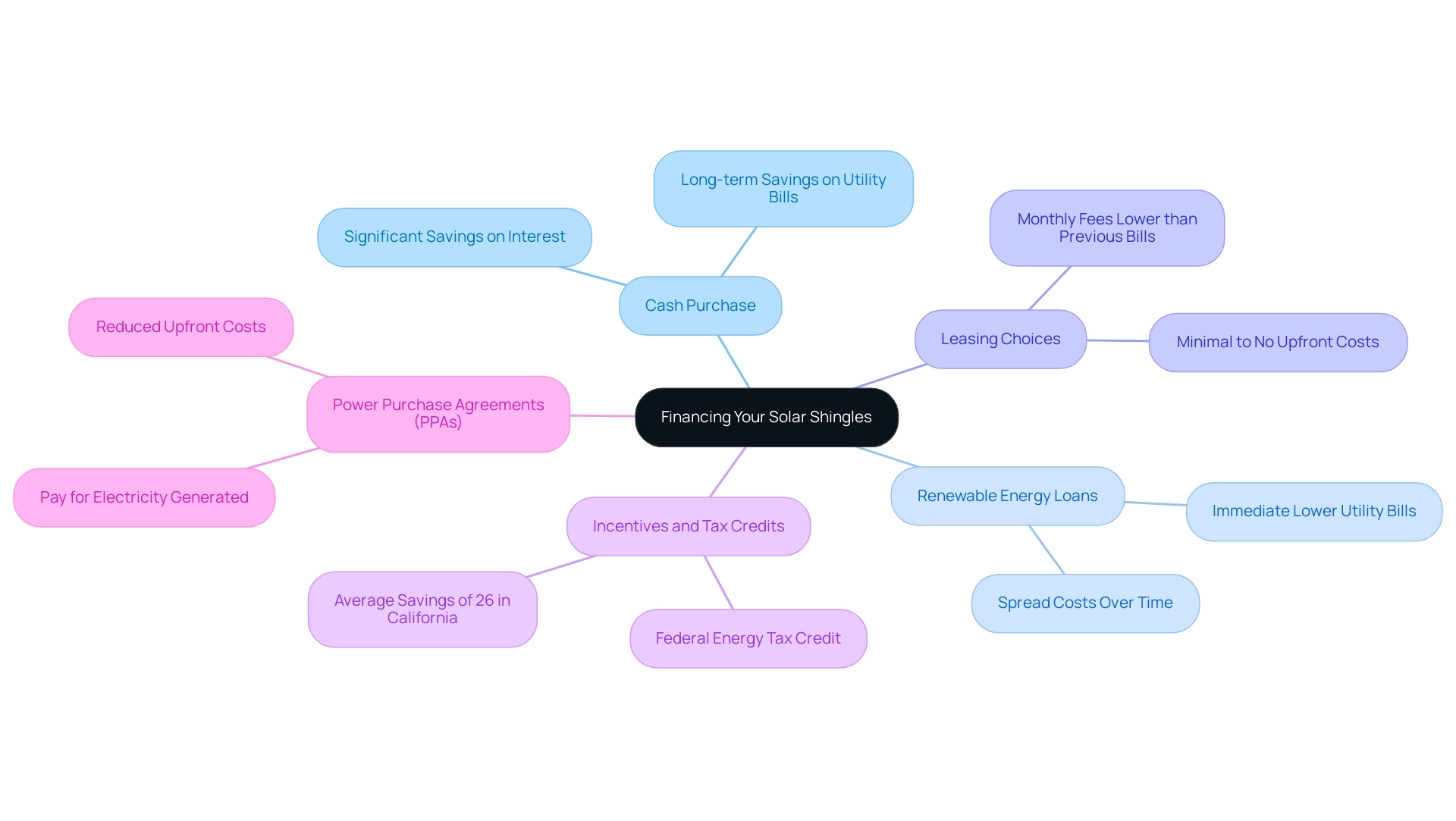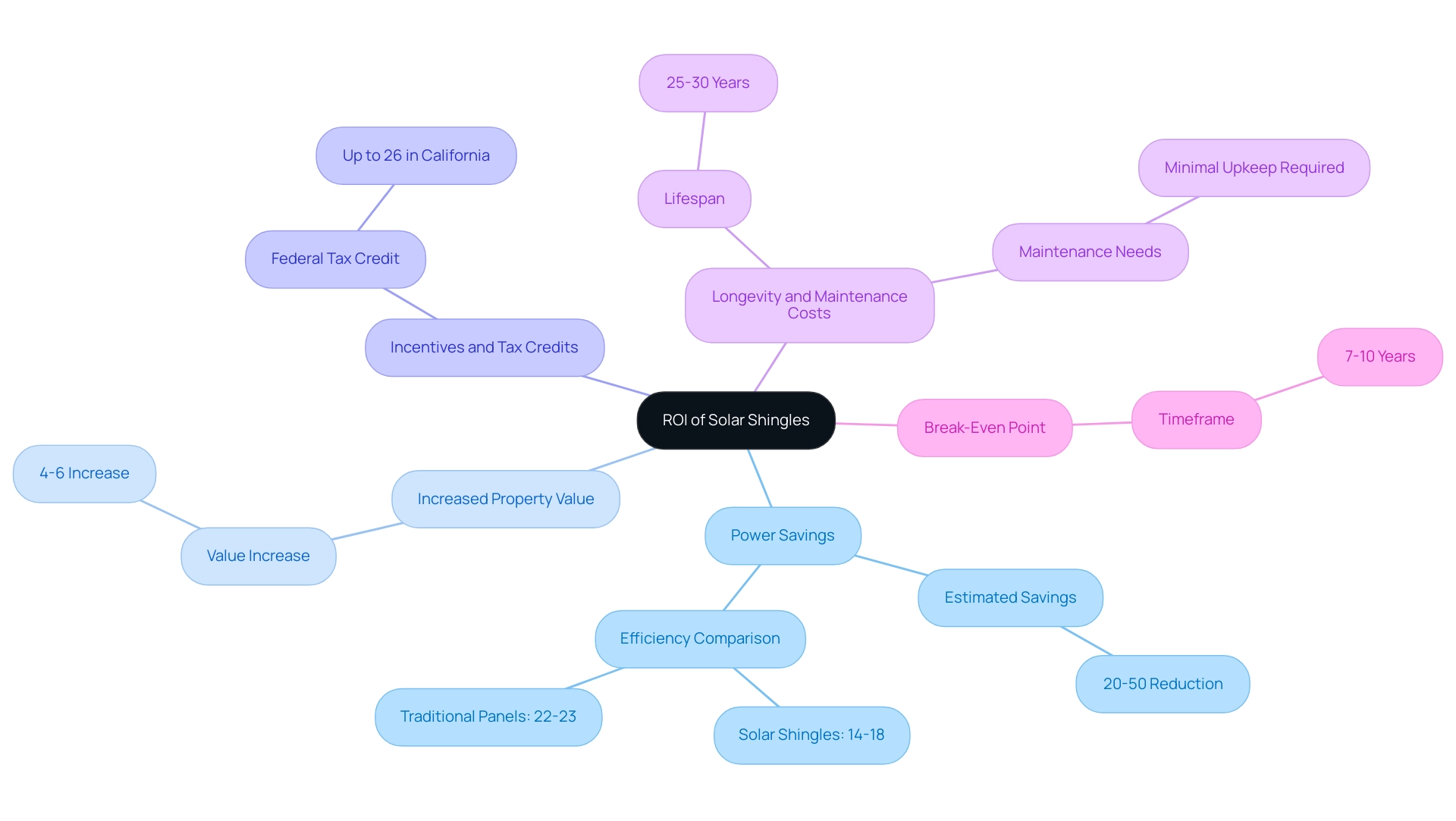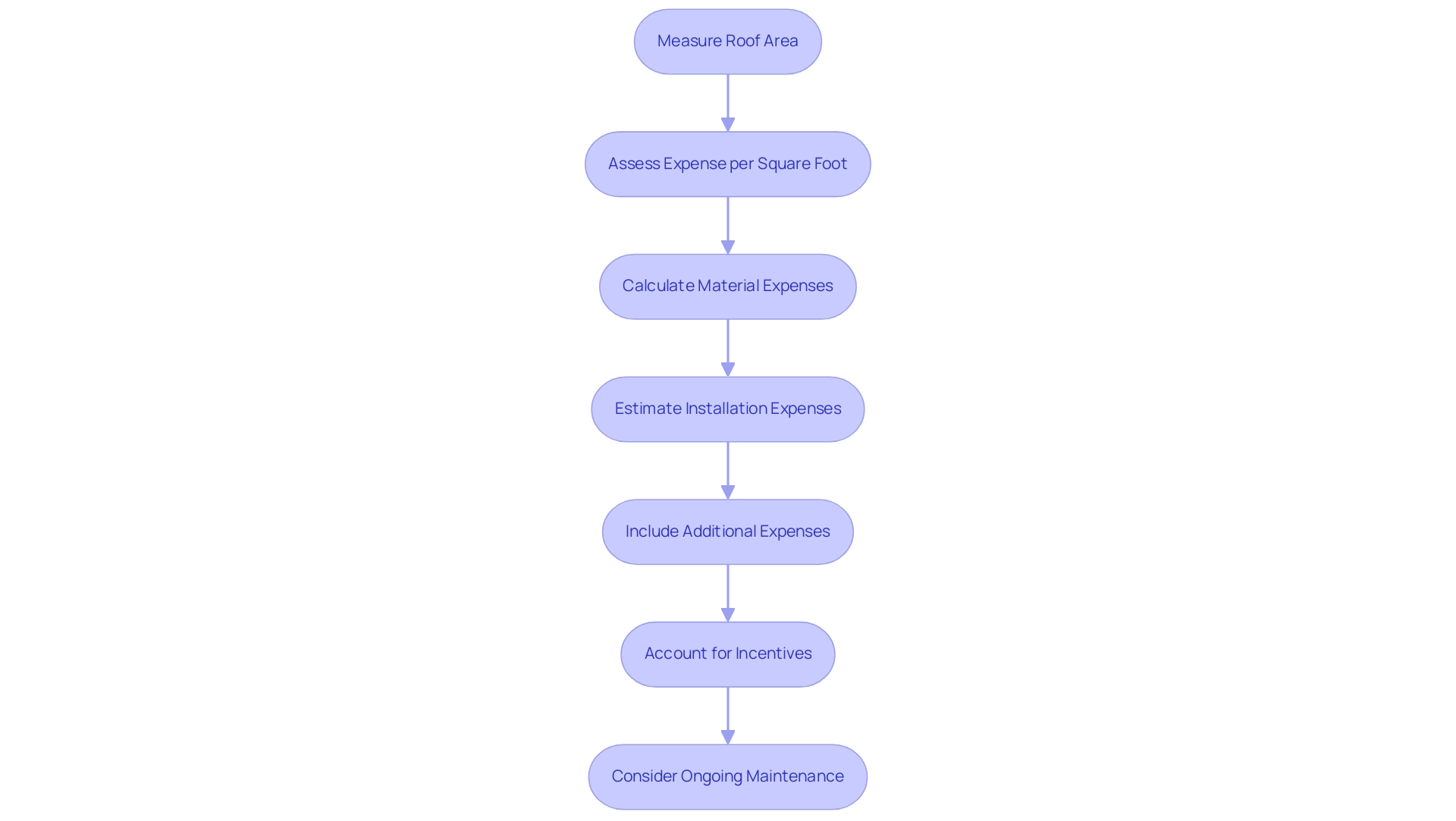Overview
This article addresses the concerns many homeowners have about rising energy bills and explores how to calculate the costs associated with solar shingles. It highlights various factors that influence pricing, such as roof size, installation complexity, and available incentives. By providing a detailed step-by-step guide, homeowners can better assess their potential expenses. Understanding these elements is crucial for making informed decisions about investing in solar energy solutions.
We understand that navigating the world of solar energy can feel overwhelming. However, the benefits of solar energy extend beyond just cost savings; they offer a path to energy independence and a more sustainable future. Together, we can explore these options and empower you to take control of your energy needs.
In conclusion, we encourage you to reach out for support and guidance as you consider this important investment. You are not alone on this journey, and we are here to help you every step of the way.
Introduction
In the quest for sustainable living, we understand that many homeowners are concerned about rising energy bills. Solar shingles have emerged as a groundbreaking solution that not only protects your home but also harnesses the sun’s energy to generate electricity. This innovative roofing material presents a compelling alternative to traditional solar panels, marrying functionality with aesthetic appeal.
As the solar energy market continues to expand, more and more homeowners are drawn to the dual benefits of solar shingles—enhanced property value and reduced energy costs. However, it’s common to feel overwhelmed by the decision to invest in solar shingles, navigating a complex landscape of costs, efficiency, and installation nuances.
Together, let’s explore the intricacies of solar shingles, comparing them with conventional solar panels, delving into their financial implications, and evaluating their long-term value as a sustainable energy solution. By understanding these aspects, we can work towards a brighter, more energy-independent future.
Understanding Solar Shingles: What They Are and How They Work
Are you feeling overwhelmed by rising energy bills? Solar tiles offer a compassionate solution that beautifully combines functionality with aesthetics. These innovative roofing materials incorporate photovoltaic cells, enabling them to harness sunlight and generate electricity while serving as a protective layer for your home. Unlike traditional photovoltaic panels that sit atop existing roofs, these energy-generating tiles are designed to seamlessly integrate into your roof framework. This not only enhances the overall appearance of your home but also aligns with your desire for energy independence.
Understanding the photovoltaic effect is key to appreciating how these tiles work. Sunlight stimulates electrons within the cells, creating an electric flow that can power your home. Imagine the relief of significantly reducing your reliance on the grid and lowering your energy bills! Furthermore, these photovoltaic shingles can enhance the value of your property, making them a wise investment for homeowners who care about both their finances and the environment.
Recent advancements in energy technology are truly exciting. The conversion efficiency of photovoltaic tiles has now reached 14.9%, showcasing the ongoing innovations in the field. The photovoltaic market is thriving, with over 30 GW of capacity installed in the U.S. as of Q3 2024, solidifying its status as the leading technology for new capacity.
Looking ahead, projections indicate that installations will stabilize at 40-45 GW annually over the next five years. This growth is supported by measures like the Inflation Reduction Act, which has improved deployment estimates by 46% compared to previous forecasts. The increasing viability of renewable solutions is something to consider for homeowners contemplating shingles.
Moreover, the economic and environmental benefits of utilizing renewable energy sources are significant. Homeowners can save between $400 to $600 each year on utility costs, while also contributing to a reduction in greenhouse gas emissions. For instance, using solar-powered heating systems can prevent about 2 tons of carbon dioxide from entering the atmosphere annually—equivalent to not driving a vehicle for four months.
As the market for photovoltaic roofing continues to expand, driven by sustainable development initiatives, North America is poised for profitable growth. This reinforces the importance of renewable energy in shaping the future of residential energy solutions.
In summary, photovoltaic roofing not only provides a sustainable energy source but also enhances the aesthetic appeal and value of homes. This makes them an attractive option for environmentally conscious homeowners like you. With Powercore Electric’s in-house team of experts ensuring high-quality installations and maintenance, you can trust in the effectiveness and reliability of your energy solutions. Powercore Electric offers a variety of roofing products tailored to meet the needs of homeowners in Stockton, California, providing you with a competitive advantage in the local energy market. Together, we can work towards a brighter, more sustainable future.
Breaking Down the Costs: Factors Influencing Solar Shingle Pricing
Many homeowners are understandably concerned about rising energy bills and the long-term costs associated with roofing solutions. The price of photovoltaic tiles can fluctuate greatly based on several important factors that can impact your decision.
-
Type of Shingle: The market offers a range of shingles from various brands, each with distinct price points. While premium brands often provide higher efficiency and durability, this can come at a greater expense. It’s important to weigh the cost of solar shingles against the long-term benefits to determine the best option for your needs. Experts suggest that solar panels might offer a better return on investment compared to the Tesla Solar Roof, especially considering Tesla’s elevated pricing compared to conventional roofing alternatives.
-
Roof Size: The total area that needs coverage is a crucial factor in overall costs. Larger roofs require more materials, which directly increases both material and installation costs. For instance, a typical 5 kW solar system in California, which may include solar shingles, can range from $9,780 to $13,232, averaging around $11,506 as of March 2025. Understanding these costs can help you make an informed decision.
-
Installation Complexity: The intricacy of your roof’s design plays a significant role in installation expenses. Roofs with steep pitches or unique architectural features may require additional labor and specialized materials, leading to higher overall expenses. It’s common to feel overwhelmed by these factors, but knowing them can help you prepare better.
-
Location: Geographic factors, including regional labor rates and local building codes, can significantly influence pricing. Areas with higher living expenses usually face increased installation charges. We understand that these regional differences can complicate your planning for energy-efficient roof installations. Powercore Electric, as a locally owned and community-focused entity, is here to offer tailored service and assistance that may help manage these expenses effectively.
-
Incentives and Rebates: Federal and state incentives can substantially lower upfront costs, making photovoltaic shingles more accessible. Currently, photovoltaic installations are eligible for a 30% federal tax credit, which can lead to significant savings. We encourage you to research available programs and incentives to maximize your financial benefits. Powercore Electric also provides various local incentives that can further enhance affordability for homeowners.
Additionally, it’s worth noting that Tesla has a customer satisfaction rating of 2.6 out of 5 stars on SolarReviews, reflecting consumer perceptions of energy products. Home improvement expert Joe Roberts points out that Tesla’s price point is much higher than what most homeowners would typically pay to replace their roof, with premium metal roofing options costing around $47 per square foot on the high end. This information is vital for homeowners like you who are evaluating the advantages of renewable energy panels against conventional roofing options.
Understanding these elements is important as you contemplate renewable energy solutions. They can lead to informed choices that improve energy autonomy and lower long-term energy expenses. By evaluating the cost breakdown and available financing options, you can navigate your investment in renewable energy technology with confidence. Together, we can work towards a more sustainable future.
Solar Shingles vs. Solar Panels: Which is the Better Investment?
When evaluating the choice between solar shingles and traditional solar panels, we understand that several critical factors must be considered:
-
Efficiency: Solar panels typically exhibit higher efficiency rates, converting a greater percentage of sunlight into electricity. As noted in recent analyses, companies like Maxeon currently offer the most efficient panels available on the residential market. This efficiency advantage means that homeowners may require fewer panels to fulfill their power needs, making them a more effective option for maximizing output. Furthermore, improvements in photovoltaic technology, including Tesla home chargers, are enhancing the overall power ecosystem for homeowners.
-
Aesthetics: We recognize that solar tiles provide a sleek, integrated appearance that blends seamlessly with the roofline. This aesthetic appeal is particularly attractive to homeowners who prioritize curb appeal and wish to maintain the architectural integrity of their homes. As consumer demand for visually appealing energy solutions increases, photovoltaic tiles are becoming a practical choice for individuals seeking to improve their property’s aesthetics while investing in renewable energy.
-
Cost: It’s common to feel concerned about the costs involved. Generally, when considering how much solar shingles cost, it’s important to note that they come with a higher price tag compared to traditional panels, both in terms of materials and installation expenses. The current price of photovoltaic tiles raises the question of how much solar shingles cost, but this cost may decrease with technological advancements and large-scale production. Homeowners should carefully assess how much solar shingles cost in relation to the aesthetic advantages and whether these benefits warrant the elevated expenses, particularly when contemplating long-term investment value. Moreover, government initiatives designed to encourage the use of renewable energy can offer financial incentives that may reduce some of these expenses. It is also important to consider the overall cost implications of maintenance, including the availability of top panel cleaning services, which can help maintain efficiency over time.
-
Installation: We understand that the setup procedure for photovoltaic tiles often requires a total roof replacement, which can greatly affect the overall project timeline and budget. In contrast, photovoltaic panels can typically be installed on existing roofs, offering a more straightforward and potentially less costly installation option. As Tom Beresnyak, a Pennsylvania State University extension educator, notes, “The installer can make a huge difference because the angle and the mount are important for maximizing what you have at that location — a skilled installer is still going to be the real key in your long-term production.”
-
Longevity and Maintenance: While both roof tiles and panels are designed for durability, panels typically have a longer lifespan and demand less upkeep. Solar shingles, being part of the roofing system, may be subject to wear and tear from environmental factors, which could necessitate more frequent inspections and maintenance. Homeowners should also consider the availability of leading panel cleaning services to maintain their systems effectively. Furthermore, examining the top battery selections for effective power storage can offer homeowners alternatives to improve their power autonomy.
As we look ahead to 2025, the renewable energy market continues to develop, with advancements in technology improving the effectiveness and cost-effectiveness of both energy panels and roofing materials. As highlighted in the case study titled ‘Future Development Trends in Solar Energy,’ photovoltaic panels will continue to dominate large-scale applications, while tiles cater to high-end markets driven by consumer demand for aesthetics and policy support for building-integrated photovoltaics. This trend suggests a future where both technologies coexist, providing options for diverse homeowner preferences and needs. Together, we can navigate these choices and find the best solution for your home.
Weighing the Pros and Cons of Solar Shingles
When considering solar shingles, it’s important to thoughtfully weigh both their benefits and drawbacks, especially if you’re concerned about energy bills.
Pros:
- Aesthetic Appeal: Solar shingles are crafted to blend seamlessly with traditional roofing materials, greatly enhancing the visual appeal of your home. This modern design can be particularly appealing to eco-conscious homeowners who value both sustainability and style.
- Dual Functionality: Serving as both a roofing material and a power generator, photovoltaic tiles can help lower overall roofing expenses. This dual purpose allows you to invest in a solution that meets both your energy and structural needs.
- Enhanced Home Worth: Homes equipped with energy-efficient roofing often see an increase in market value. Research indicates that properties with energy-saving features, like photovoltaic tiles, may experience a property value increase of up to 4%, making them a wise investment for homeowners.
Cons:
- Higher Initial Costs: The initial investment for solar shingles typically surpasses that of traditional solar panels. For an average U.S. residence, the total expense for a rooftop made of renewable energy panels can range from $35,000 to $70,000, influenced by factors like roof size and complexity. Additionally, standard roofing costs vary from $3.50 to $5.50 per square foot, which provides a context for understanding the relative costs of solar shingles compared to conventional roofing.
- Lower Efficiency: While photovoltaic tiles offer a practical power solution, they generally produce less electricity than conventional panels. As Sarah Drolet noted, “You’ll require as many roof tiles as necessary to satisfy your home’s power requirements.” This reduced efficiency may necessitate the addition of more roofing materials to meet your household’s energy needs, potentially increasing overall expenses.
- Installation Complexity: Installing photovoltaic tiles can be more intricate than setting up traditional panels, often requiring a complete roof replacement. This complexity can lead to extended project timelines and additional labor costs.
Homeowners have had varied experiences with photovoltaic shingles. Many appreciate the aesthetic benefits and seamless integration into their homes, while others voice concerns about the initial investment and efficiency. Expert opinions also reflect these pros and cons, emphasizing the importance of considering your individual energy needs and financial situation before making a decision.
Moreover, financing options such as home equity loans, HELOCs, and renewable energy loans can make these investments more accessible, allowing you to benefit from lower interest rates and tax incentives.
Regarding longevity, most photovoltaic roofs are designed to last between 20 and 30 years, with warranties typically lasting at least 25 years, providing reassurance about the durability of your investment.
In summary, while photovoltaic shingles offer a unique blend of utility and design, it’s essential to evaluate their financial implications and energy production to ensure they align with your long-term goals. Additionally, exploring optimal battery options for energy storage, such as those offered by Powercore Electric, can enhance the efficiency of your solar systems, helping you maximize your investment. For a deeper understanding of how photovoltaic panels function, we encourage you to refer to the user manuals provided by Powercore Electric, which detail the operation and advantages of these energy solutions.
Installation Insights: What to Expect When Installing Solar Shingles
Installing solar shingles is a journey that involves several essential steps, ensuring a smooth transition to solar energy for your home.
-
Initial Assessment: We understand that your roof’s condition, size, and orientation are significant concerns. A qualified expert will assess these factors to determine the feasibility of installing photovoltaic panels. This evaluation is vital for recognizing any possible challenges and ensuring optimal power production.
-
Design and Planning: After the assessment, we create a tailored solar roofing design just for you. This design aims to maximize energy output while maintaining the aesthetic appeal of your home, ensuring that the installation complements your existing architecture.
-
Permitting: Before we can begin installation, necessary permits must be secured from local authorities. It’s common to feel overwhelmed by this process, as it can vary significantly depending on your location. We’re here to help you navigate this part of the journey.
-
Installation: The actual installation process typically takes between 1 to 3 days, depending on the size and complexity of your roof. Solar tiles are installed similarly to traditional roofing materials, ensuring a watertight seal that protects your home from the elements. It’s important to recognize that when considering the costs, the expense of installing roof tiles for renewable energy is typically 15%-25% greater than that of conventional panel systems. This is a vital factor to consider as you make your decision.
-
Connection to Electrical System: Once the shingles are securely in place, they are connected to your home’s electrical system. This link enables you to start producing power right away, aiding in your independence from external sources. As Marty Ford, Shingle Master and President of Bullet Proof Roof Systems, states, “[Solar roofs] can help to reduce your utility costs and even make your home self-sufficient.”
-
Inspection and Activation: After installation, a final inspection is conducted to ensure that all components meet local building codes and safety standards. Once authorized, the system is initiated, enabling you to begin enjoying the advantages of renewable power.
Transitioning to photovoltaic roofing not only decreases your home’s carbon footprint but also provides a beneficial return on investment. A recent case analysis titled ‘Return on Investment for Shingles’ emphasized that homeowners can anticipate substantial financial advantages from investing in shingles, including the costs involved, as well as tax incentives and lower utility expenses. Additionally, you can take advantage of government programs for energy systems that provide incentives and support for transitioning to renewable energy, such as rebates and tax credits.
These programs can significantly offset the initial costs of installation. As the technology continues to advance, the percentage of homes appropriate for photovoltaic installation is growing, making this an appealing choice for environmentally aware homeowners. Understanding how photovoltaic panels operate—by transforming sunlight into electricity through photovoltaic cells—further increases the value of this investment, ensuring you are well-informed about your power options. Together, we can explore how this sustainable solution can benefit you and your family.
Financing Your Solar Shingles: Incentives and Payment Options
Navigating the financing of solar shingles can feel overwhelming, especially when considering the impact on your energy bills. However, various methods exist that not only alleviate financial concerns but also align with your desire for sustainable energy solutions, particularly through Powercore Electric.
-
Cash Purchase: Opting for an upfront payment can lead to significant savings on interest expenses. While this approach requires considerable capital, which may not be feasible for every homeowner, purchasing roof tiles directly from Powercore Electric allows you to understand the cost of solar shingles. This choice can translate into long-term savings on utility bills compared to traditional electricity expenses.
-
Renewable Energy Loans: Many lenders now offer loans specifically designed for photovoltaic systems. This option allows you to spread the costs over time while immediately benefiting from lower utility bills. With the growing adoption of photovoltaic technology, funding alternatives have become more accessible, empowering you to invest in renewable sources and enjoy the financial perks associated with them.
-
Leasing Choices: Companies like Powercore Electric provide leasing agreements that enable you to install photovoltaic shingles with minimal to no upfront costs. Instead of purchasing the system outright, you pay a monthly fee, often lower than your previous electricity bills, easing the financial burden. This model is particularly attractive for eco-conscious homeowners who are curious about the cost of solar shingles while wishing to transition to renewable energy without a significant initial investment.
-
Incentives and Tax Credits: You may qualify for various federal and state incentives, including the federal energy tax credit, which can cover a substantial portion of installation costs. For instance, in California, homeowners can save an average of 26% on their energy investments through these credits. Exploring local initiatives can reveal additional savings opportunities, making renewable sources even more appealing compared to conventional electricity.
-
Power Purchase Agreements (PPAs): With this arrangement, you pay for the electricity generated by the roof tiles rather than the tiles themselves. This model can greatly reduce upfront costs, allowing you to enjoy the benefits of renewable energy without the initial financial commitment, which raises the question of the cost of solar shingles and underscores the value of such solutions.
As you consider these funding options, choosing a reliable contractor for photovoltaic installation, like Powercore Electric, is essential. As highlighted in the case study titled “Choosing a Solar Installer,” taking the time to research reviews, verify credentials, and ensure proper licensing and insurance are crucial steps in this journey. By making informed decisions, you can enhance the likelihood of a successful renewable energy project.
Moreover, the performance benefits of photovoltaic shingles are noteworthy. For example, Luma Solar boasts an efficiency rating of 22.10% and a wattage per square foot of 14.9, showcasing the potential for power savings and self-sufficiency that these roofs can provide. As Marty Ford, Shingle Master and President of Bullet Proof Roof Systems, emphasizes, ‘[Solar roofs] can assist in reducing your utility bills and even make your home self-sufficient.’
This technology holds immense potential, and I look forward to engaging with it in the near future.
It’s also crucial to recognize that the shift towards renewable energy is increasingly reaching less affluent households, making financing options more accessible for a wider audience. Understanding these choices is vital for maximizing the benefits of renewable power, especially for eco-conscious homeowners eager to lower their utility expenses and enhance their energy independence. Together, we can explore these options and work towards a sustainable future.
Evaluating the Long-Term Value: ROI of Solar Shingles
Evaluating the return on investment (ROI) of solar shingles is an important step for homeowners seeking to alleviate energy costs. We understand that rising utility bills can be a source of stress, and exploring sustainable solutions can feel overwhelming. However, a thorough analysis of several key factors can illuminate the path to energy independence.
-
Power Savings: Begin by estimating how much you could save on your utility bills. This involves assessing your home’s power usage alongside the anticipated electricity production from solar shingles. Many homeowners report savings of 20-50% on their monthly utility costs, influenced by regional power rates and the effectiveness of the tiles. It’s worth noting that typical roofing brands range from 14-18% efficiency, while most solar panels achieve 22-23% efficiency, providing a clear perspective on potential power generation capabilities.
-
Increased Property Value: Beyond energy savings, solar shingles can enhance your home’s market value. Research shows that homes with solar installations often experience a property value increase of approximately 4-6%. This makes them a valuable long-term investment, providing both financial benefits and peace of mind.
-
Incentives and Tax Credits: Financial incentives, such as federal tax credits and state rebates, can significantly improve your ROI. For example, California homeowners can benefit from a federal tax credit of up to 26% of the installation expenses, which can substantially offset the initial investment. This support can make the transition to solar energy more accessible and rewarding.
-
Longevity and Maintenance Costs: Solar shingles typically have a lifespan of 25-30 years. While they require minimal maintenance, it’s essential to consider any potential upkeep or repair costs over time. Regular maintenance can ensure optimal performance and longevity, ultimately enhancing your overall ROI.
-
Break-Even Point: Understanding the break-even point is crucial for assessing financial viability. This is the timeframe in which the savings from reduced utility bills and increased property value equal your initial investment. On average, homeowners can expect to reach this balance within 7-10 years, depending on savings and local market conditions.
Moreover, as Marques Brownlee pointed out, “the advantages of seamless integration with his Tesla vehicle, EV charger, and Powerwall batteries surpassed the additional expense.” This highlights the importance of evaluating how solar panels can align with your current power solutions, creating a more efficient and sustainable home.
It’s essential to acknowledge that photovoltaic tiles may not be suitable for every rooftop and require expert installation. Consulting with professionals like Powercore Electric, who have proudly served California for over 30 years, can ensure that you make informed decisions tailored to your specific needs. Their regional knowledge and commitment to high-quality workmanship can further enhance the value of investing in photovoltaic roofing. Together, we can optimize your financial gains while supporting sustainable energy practices.
Step-by-Step Calculation: How to Determine Your Solar Shingle Costs
Determining the cost of solar shingles for your home involves several important steps to ensure an accurate assessment. We understand that navigating this process can feel overwhelming, so here’s a supportive guide to help you:
-
Measure Your Roof Area: Start by calculating the total square footage of your roof that will be covered by photovoltaic tiles. This measurement is crucial as it directly influences both the overall cost and the efficiency of your energy system.
-
Assess the Expense per Square Foot: Take the time to investigate the average price of solar tiles in your area. As of 2025, in California, prices typically range from $21 to $25 per square foot, reflecting the quality and technology of the shingles. Understanding these costs can help you feel more prepared.
-
Calculate Material Expenses: Multiply the total square footage by the price per square foot to estimate your material expenses. For instance, if your roof area is 1,000 square feet and the price is $23 per square foot, your material expense would be approximately $23,000. This clarity can ease your budgeting concerns.
-
Estimate Installation Expenses: Labor charges can vary significantly based on your location and the complexity of the installation. Generally, you should anticipate adding an extra 20-30% to your material expenses for installation. For example, if your material expenses are $23,000, installation could add another $4,600 to $6,900. It’s common to feel uncertain about these added costs, but being informed can help.
-
Include Additional Expenses: Don’t forget to consider other potential charges such as permits, inspections, and any necessary roof repairs before installation. These can add several hundred to a few thousand dollars to your total project expense. Understanding these factors can help you plan more effectively.
-
Account for Incentives: Finally, subtract any applicable tax credits or incentives from your total cost. Many homeowners can benefit from federal and state incentives, which can significantly reduce the net investment. For instance, if you qualify for a $5,000 tax credit, your adjusted total would reflect this saving, making energy-efficient shingles an even more appealing option.
-
Consider Ongoing Maintenance: Annual upkeep for photovoltaic panels includes cleaning and inspections, inverter replacements, and potential wiring repairs. Recognizing these ongoing costs is essential for a comprehensive financial commitment. Regular maintenance not only ensures efficiency but also extends the longevity of your energy system.
By following these steps, you can gain a clearer understanding of how much solar shingles cost and the financial commitment involved in installing roof tiles. Additionally, obtaining multiple quotes from different installers can lead to savings of up to 20%. As highlighted in the case study “Comparing Multiple Solar Quotes,” Catherine Lane, a Written Content Manager at SolarReviews, notes that ‘photovoltaic panels can cost 20% less when you compare multiple quotes.’
With photovoltaic panels typically covering their costs in 7 to 12 years, and homeowners in regions with high electricity rates possibly achieving balance in just 5 to 7 years, investing in these roofing materials can be a financially wise choice for many property owners. This average payback period emphasizes the long-term financial benefits of investing in solar shingles, especially when considering innovative solutions available, such as Tesla home chargers and efficient solar battery options. Together, we can explore these options and find the best solution for your needs.
Conclusion
We understand that many homeowners are concerned about rising energy bills and the impact of these costs on their budgets. Solar shingles present a unique opportunity for you to embrace sustainable energy solutions while enhancing the aesthetic appeal of your home. By integrating photovoltaic technology into roofing materials, solar shingles generate electricity without compromising the visual integrity of your property. The benefits of solar shingles extend beyond mere energy generation; they can significantly lower your energy bills, increase your property value, and contribute to a more sustainable future.
While the initial investment for solar shingles may be higher than traditional solar panels, the long-term value is undeniable. Factors such as energy savings, potential increases in home value, and available financial incentives can make solar shingles a worthwhile investment. We encourage you to carefully consider your individual circumstances, including roof size, installation complexity, and local market conditions, to make informed decisions that align with your energy goals.
In conclusion, transitioning to solar shingles is not just a trend but a strategic move towards energy independence and sustainability. As the solar market evolves and technology advances, you have the opportunity to invest in a solution that not only meets your energy needs but also enhances your home’s beauty and value. Together, we can embrace solar energy through shingles, paving the way for a brighter, more sustainable future. This makes it an appealing choice for eco-conscious homeowners like you, and we are here to support you every step of the way.


